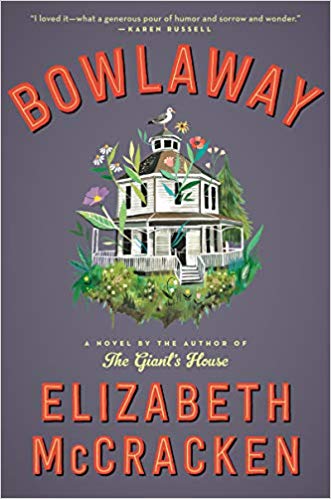
Elizabeth McCracken’s ‘Bowlaway’ Spins a Dark, Magical Tale of Love, Loss and Bowling
The Austin author is mostly concerned with pain: how we inflict it on each other, and how we keep going, year after year, as our burdens pile up.

Above: Candlepin bowling.
“They found a body in the Salford Cemetery, but aboveground and alive.”
That thunderbolt of a sentence opens Elizabeth McCracken’s new novel, Bowlaway, and sets the tone for what’s to follow: a story equal parts sorrow and wonder, magical realism and cold, hard reality. The longtime Austin author and University of Texas professor — whose roots in the Texas literary community are so deep that three people I asked to write this review turned me down on account of knowing her too well — has always walked the line between beauty and loss. Her 2008 memoir, An Exact Replica of a Figment of My Imagination, was an unflinching account of losing a child; The Giant’s House, her acclaimed first novel in 1996, was an oddball romance infused with melancholy. Bowlaway treads what at first appears to be quirky, lighthearted territory, tracking the colorful characters who pass through a candlepin bowling alley in a small Massachusetts town in the early 1900s. The floral illustration on the cover and the jacket copy, which bills the book as “sweeping and enchanting,” add to this illusion. In fact, Bowlaway is mostly concerned with pain: how we inflict it on each other, and how we keep going, year after year, as our burdens pile up.

Ecco Books
$27.99; 384 pages
If that sounds bleak, know that McCracken’s gift is to deliver that pain wrapped in astounding sentences and characters who leap off the page. Bertha Truitt, whose body turns up in the cemetery, is “a plump five and a half feet tall, her uncorsetted torso rhomboid, sensual.” An unapologetic feminist, she’s the type of person who “rode a bicycle around the city in her split skirt and never wobbled even when the sidewalk boys hooted at her.” She soon opens Truitt’s Alleys and makes the then-unconventional choice of welcoming women to bowl alongside the men.
The alley attracts a pack of misfits, and each chapter focuses loosely on one of them. There’s Leviticus Sprague, an alcoholic doctor and poet fond of long walks, and Joe Wear, a closeted orphan. Nahum Truitt, who poses as Bertha’s son so he can inherit the alley, is a preacher and gambling addict, and LuEtta Mood has lost a child and comes to the alley because “she’d heard it was possible to bowl away sorrow.” A group of military veterans, some missing limbs, forms a team called the Half Nickels. All are eager for the distraction of candlepin, a variant of the game still played in New England today. Their stories are so universally sad that, were they told by a less skilled author, you might abandon the book in despair. But McCracken finds ways to make them surprising, even funny, as when a drunken 11-year-old pinsetter falls asleep on the job and crashes onto the lane. Lying there in confusion, he wonders “why one of his feet was so cold, how long he’d been gone from the conscious world, who put that bite of ham sandwich at the back of his mouth right where it could choke him.” When he recovers, someone cheers, “The boy is entire!”
Much of the pleasure of Bowlaway lies in its poetry; the book is best read pen in hand, ready to underline standout sentences. One of my favorites came early on, during a discussion of whether Bertha’s claim that she invented candlepin bowling could be true. McCracken concludes that the myth matters most, writing: “We all of us have invented things that others have beat us to: walking upright, a certain sort of sandwich involving avocado and an onion roll, a minty sweet cocktail, ourselves, romantic love, human life.”
McCracken’s gift is to deliver that pain wrapped in astounding sentences and characters who leap off the page.
The book’s persistent sadness is also leavened by a touch of magic. People die in fantastic ways: spontaneous combustion, drowning in a molasses flood (the latter based, incredibly, on a true story). The alley may or may not be haunted by ghosts, who show themselves only in photographs. And there’s a memorable sighting of a boogeyman called the Salford Devil: “The thing hissed and fled: oily waddle, blurping noise of a stout body sliding into swamp.”
You don’t read a McCracken book for plot or speed, and I felt my attention start to lag about two-thirds through. Things pick up when a pair of brothers, Arch and Roy, enter the narrative. Arch struggles with alcoholism, while Roy, sensitive and intellectual, becomes a professor and a compulsive lockpicker; they both fall in love with the same woman. Their rapport feels real, blending affection and irritation in the way that only siblings can. Eventually, they open a new bowling alley together.
By the final chapter, the original alley has been the site of a birth and at least two deaths, let alone countless stolen kisses, fights and secrets. Bertha, long gone, still inhabits the alley in the form of a life-size wooden doll. Hand-carved after her death at the request of her grieving husband, dragged around and forgotten for a time, the doll is scuffed and worn. It sits atop a pinball machine, watching the next generation of bowlers lace up their shoes. In the end, it may not be possible to bowl away sorrow, but it does help pass the time.


